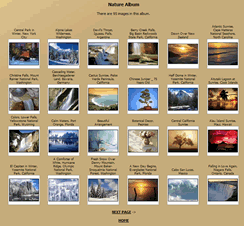

- #Best gallery script for offering free graphic downloads how to#
- #Best gallery script for offering free graphic downloads code#
- #Best gallery script for offering free graphic downloads download#
The cv2.Stitcher_create function for OpenCV 4 has a similar signature: Stitcher_create(.) OpenCV’s GPU support is limited and I’ve never been able to get this parameter to work so I recommend always leaving it as False. Notice how this function has only a single parameter, try_gpu which can be used to improve your the throughout of your image stitching pipeline. OpenCV has already implemented a method similar to Brown and Lowe’s paper via the cv2.createStitcher (OpenCV 3.x) and cv2.Stitcher_create (OpenCV 4) functions.Īssuming you have OpenCV properly configured and installed you’ll be able to investigate the function signature of cv2.createStitcher for OpenCV 3.x: createStitcher(.)ĬreateStitcher() -> retval The cv2.createStitcher and cv2.Stitcher_create functions Figure 2: The constructor signature for creating a Stitcher class object with OpenCV. Using command line arguments, you can easily change the filename + path of the output image. The last file, output.png, is the name of the resulting stitched image.
The algorithm we’ll be using here today is similar to the method proposed by Brown and Lowe in their 2007 paper, Automatic Panoramic Image Stitching with Invariant Features. OpenCV’s image stitching algorithm Figure 1: The stitching module pipeline implemented in the Stitcher class ( source). We’ll review the results of this first script, note its limitations, and then implement a second Python script that can be used for more aesthetically pleasing image stitching results.įinally, we’ll review the results of our second script and again note any limitations or drawbacks.

In the first part of today’s tutorial, we’ll briefly review OpenCV’s image stitching algorithm that is baked into the OpenCV library itself via cv2.createStitcher and cv2.Stitcher_create functions.įrom there we’ll review our project structure and implement a Python script that can be used for image stitching.
#Best gallery script for offering free graphic downloads code#
Looking for the source code to this post? Jump Right To The Downloads Section Image Stitching with OpenCV and Python
#Best gallery script for offering free graphic downloads how to#
To learn how to stitch images with OpenCV and Python, just keep reading! In today’s tutorial, we’ll be revisiting image stitching with OpenCV, including how to stitch more than two images together into a panoramic image. However, the biggest problem with my original implementations is that they were not capable of handling more than two input images.

#Best gallery script for offering free graphic downloads download#
Click here to download the source code to this post


 0 kommentar(er)
0 kommentar(er)
